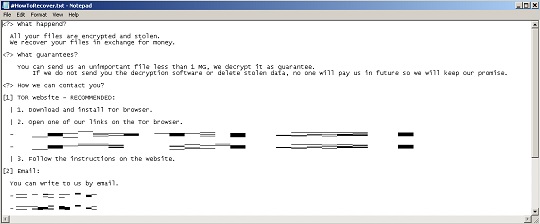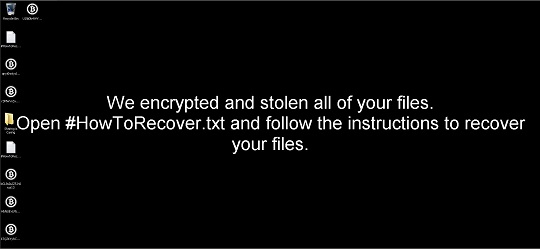Ransom.Win64.HORUSKRYPT.THIAGBD
Ransom:Win64/Akira.CCDR!MTB
Windows


Threat Type: Ransomware
Destructiveness: No
Encrypted: No
In the wild: Yes
OVERVIEW
This Ransomware arrives on a system as a file dropped by other malware or as a file downloaded unknowingly by users when visiting malicious sites.
It encrypts files found in specific folders. It drops files as ransom note. It avoids encrypting files with the following file extensions.
TECHNICAL DETAILS
Arrival Details
This Ransomware arrives on a system as a file dropped by other malware or as a file downloaded unknowingly by users when visiting malicious sites.
Installation
This Ransomware drops the following copies of itself into the affected system:
- %User Startup%\{32 random alphanumeric}.exe
(Note: %User Startup% is the current user's Startup folder, which is usually C:\Windows\Profiles\{user name}\Start Menu\Programs\Startup on Windows 98 and ME, C:\WINNT\Profiles\{user name}\Start Menu\Programs\Startup on Windows NT, C:\Documents and Settings\{User name}\Start Menu\Programs\Startup on Windows 2003(32-bit), XP and 2000(32-bit), or C:\Users\{user name}\AppData\Roaming\Microsoft\Windows\Start Menu\Programs\Startup on Windows Vista, 7, 8, 8.1, 2008(64-bit), 2012(64-bit), 10(64-bit).)
It drops the following files:
- %ProgramData%\{32 random alphanumeric}.ico → icon of encrypted files
- %ProgramData%\{32 random alphanumeric}.bmp → desktop wallpaper after encryption
(Note: %ProgramData% is a version of the Program Files folder where any user on a multi-user computer can make changes to programs. This contains application data for all users. This is usually C:\ProgramData on Windows Vista, 7, 8, 8.1, 2008(64-bit), 2012(64-bit) and 10(64-bit), or C:\Documents and Settings\All Users on Windows Server 2003(32-bit), 2000(32-bit) and XP.)
It adds the following processes:
- vssadmin Delete Shadows /All /Quiet
- bcdedit /set {default} recoveryenabled No
- bcdedit /set {default} bootstatuspolicy ignoreallfailures
- wmic SHADOWCOPY /nointeractive
It adds the following mutexes to ensure that only one of its copies runs at any one time:
- 51A301AD-3CCF-413A-AD80-A507DDCFF34C
Other System Modifications
This Ransomware adds the following registry entries:
HKEY_CLASSES_ROOT\.h0rus13\DefaultIcon
{default} = %ProgramData%\{32 random alphanumeric}.ic
HKEY_CURRENT_USER\Software\Krypt
public = {hex values}
HKEY_CURRENT_USER\Software\Krypt
full = {hex values}
It modifies the following registry entries:
HKEY_LOCAL_MACHINESoftware\Policies\Microsoft\
Windows Defender
DisableAntiSpyware = 1
HKEY_LOCAL_MACHINESoftware\Policies\Microsoft\
Windows Defender
DisableRealtimeMonitoring = 1
HKEY_LOCAL_MACHINE\Software\Policies\
Microsoft\Windows NT\SystemRestore
DisableSR = 1
HKEY_LOCAL_MACHINE\Software\Policies\
Microsoft\Windows NT\SystemRestore
DisableConfig = 1
HKEY_LOCAL_MACHINE\Software\Policies\
Microsoft\Windows\WinRE
DisableSetup = 1
HKEY_LOCAL_MACHINE\Software\Policies\
Microsoft\Windows\Backup\
Client
DisableRestoreUI = 1
HKEY_LOCAL_MACHINE\Software\Policies\
Microsoft\Windows\Backup\
Client
DisableBackupLauncher = 1
HKEY_LOCAL_MACHINE\Software\Policies\
Microsoft\Windows\Backup\
Client
DisableSystemBackupUI = 1
HKEY_LOCAL_MACHINE\Software\Policies\
Microsoft\Windows\Backup\
Client
DisableBackupUI = 1
It sets the system's desktop wallpaper to the following image:
Process Termination
This Ransomware terminates the following services if found on the affected system:
- wrapper
- DefWatch
- ccEvtMgr
- ccSetMgr
- SavRoam
- Sqlservr
- sqlagent
- sqladhlp
- Culserver
- RTVscan
- sqlbrowser
- SQLADHLP
- QBIDPService
- Intuit.QuickBooks.FCS
- QBCFMonitorService
- msmdsrv
- tomcat6
- zhudongfangyu
- vmware-usbarbitator64
- vmware-converter
- dbsrv12
- dbeng8
- MSSQL$MICROSOFT##WID
- MSSQL$VEEAMSQL2012
- SQLAgent$VEEAMSQL2012
- SQLBrowser
- SQLWriter
- FishbowlMySQL
- MSSQL$MICROSOFT##WID
- MySQL57
- MSSQL$KAV_CS_ADMIN_KIT
- MSSQLServerADHelper100
- SQLAgent$KAV_CS_ADMIN_KIT
- msftesql-Exchange
- MSSQL$MICROSOFT##SSEE
- MSSQL$SBSMONITORING
It terminates the following processes if found running in the affected system's memory:
- wxserver
- wxserverview
- sqlmangr
- ragui
- supervise
- culture
- defwatch
- winword
- qbw32
- qbdbmgr
- qbupdate
- axlbridge
- httpd
- fdlauncher
- msdtsrvr
- java
- 360se
- 360doctor
- wdswfsafe
- fdhost
- gdscan
- zhudongfangyu
- qbdbmgrn
- mysqld
- autodeskdesktopapp
- acwebbrowser
- creative cloud
- adobe desktop service
- coresync
- adobe cef
- helper
- node
- adobeipcbroker
- sync-taskbar
- sync-worker
- inputpersonalization
- adobecollabsync
- brctrlcntr
- brccuxsys
- simplyconnectionmanager
- simply.systemtrayicon
- fbguard
- fbserver
- onenotem
- wsa_service
- koaly-exp-engine-service
- teamviewer_service
- teamviewer
- tv_w32
- tv_x64
- titanv
- ssms
- notepad
- rdrcef
- sam
- oracle
- ocssd
- dbsnmp
- synctime
- agntsvc
- isqlplussvc
- xfssvccon
- mydesktopservice
- ocautoupds
- encsvc
- tbirdconfig
- mydesktopqos
- ocomm
- dbeng50
- sqbcoreservice
- exce
- infopath
- msaccess
- mspub
- onenote
- outlook
- powerpnt
- steam
- thebat
- thunderbird
- visio
- wordpad
- bedbh
- vxmon
- benetns
- bengien
- pvlsvr
- beserver
- raw_agent_svc
- vsnapvss
- cagservice
- dellsystemdetect
- enterpriseclient
- processhacker
- procexp64
- procexp
- glasswire
- gwctlsrv
- wireshark
- dumpcap
- j0gnjko1
- autoruns
- autoruns64a
- autorunsc
- autorunsc64a
- sysmon
- sysmon64
- procexp64a
- procmon
- procmon64
- procmon64a
- adexplorer
- adexplorer64
- adexplorer64a
- tcpview
- tcpview64
- tcpview64a
- avz
- tdsskiller
- raccineelevatedcfg
- raccinesettings
- raccine_x86
- raccine
- sqlservr
- rtvscan
- sqlbrowser
- tomcat6
- qbidpservice
- notepad++
- systemexplorer
- systemexplorerservice
- systemexplorerservice64
- totalcmd
- totalcmd64
- veeamdeploymentsvc
- notepad
Information Theft
This Ransomware gathers the following data:
- Volume Information
Other Details
This Ransomware adds the following registry keys:
HKEY_CURRENT_USER\Software\Krypt
HKEY_CLASSES_ROOT\.h0rus13
HKEY_CLASSES_ROOT\.h0rus13\DefaultIcon
HKEY_CURRET_USER\.h0rus13
HKEY_CURRET_USER\.h0rus13\DefaultIcon
It does the following:
- It encrypts local, removable, and network drives.
- It empties the recycle bin.
- It terminates itself if the keyboard layout of the infected machine is the following:
- Persian/Iran
- It terminates itself if the GUID was found in the system:
- 51A301AD-3CCF-413A-AD80-A507DDCFF34C
- It changes the encrypted file icon to the following image:

Ransomware Routine
This Ransomware encrypts files found in the following folders:
- ProgramData
- Program Files (x86)
It avoids encrypting files with the following strings in their file name:
- #HowToRecover.txt
- BOOTSECT.BAK
- pagefile.sys
- bootmgr
It renames encrypted files using the following names:
- {10 random alphanumeric}.h0rus13
It appends the following extension to the file name of the encrypted files:
- .h0rus13
It drops the following file(s) as ransom note:
- {encrypted directory}\#HowToRecover.txt
- %Desktop%\#HowToRecover.txt

It avoids encrypting files with the following file extensions:
- exe
- bmp
- dll
- msi
- ico
SOLUTION
Step 1
Trend Micro Predictive Machine Learning detects and blocks malware at the first sign of its existence, before it executes on your system. When enabled, your Trend Micro product detects this malware under the following machine learning name:
- Troj.Win32.TRX.XXPE50FFF086
Step 2
Before doing any scans, Windows 7, Windows 8, Windows 8.1, and Windows 10 users must disable System Restore to allow full scanning of their computers.
Step 3
Note that not all files, folders, and registry keys and entries are installed on your computer during this malware's/spyware's/grayware's execution. This may be due to incomplete installation or other operating system conditions. If you do not find the same files/folders/registry information, please proceed to the next step.
Step 4
Delete this registry key
Important: Editing the Windows Registry incorrectly can lead to irreversible system malfunction. Please do this step only if you know how or you can ask assistance from your system administrator. Else, check this Microsoft article first before modifying your computer's registry.
- In HKEY_CURRENT_USER\Software\Krypt
- In HKEY_CLASSES_ROOT\.h0rus13
- In HKEY_CLASSES_ROOT\.h0rus13\DefaultIcon
- In HKEY_CURRET_USER\.h0rus13
- In HKEY_CURRET_USER\.h0rus13\DefaultIcon
Step 5
Delete this registry value
Important: Editing the Windows Registry incorrectly can lead to irreversible system malfunction. Please do this step only if you know how or you can ask assistance from your system administrator. Else, check this Microsoft article first before modifying your computer's registry.
- In HKEY_CLASSES_ROOT\.h0rus13\DefaultIcon
- {default} = %ProgramData%\{32 random alphanumeric}.ico
- {default} = %ProgramData%\{32 random alphanumeric}.ico
- In HKEY_CURRENT_USER\Software\Krypt
- public = {hex values}
- public = {hex values}
- In HKEY_CURRENT_USER\Software\Krypt
- full = {hex values}
- full = {hex values}
Step 6
Restore this modified registry value
Important: Editing the Windows Registry incorrectly can lead to irreversible system malfunction. Please do this step only if you know how or you can ask assistance from your system administrator. Else, check this Microsoft article first before modifying your computer's registry.
RESTOREStep 7
Search and delete this file
- %User Startup%\{32 random alphanumeric}.exe
- %ProgramData%\{32 random alphanumeric}.ico
- %ProgramData%\{32 random alphanumeric}.bmp
- {encrypted directory}\#HowToRecover.txt
- %Desktop%\#HowToRecover.txt
Step 8
Scan your computer with your Trend Micro product to delete files detected as Ransom.Win64.HORUSKRYPT.THIAGBD. If the detected files have already been cleaned, deleted, or quarantined by your Trend Micro product, no further step is required. You may opt to simply delete the quarantined files. Please check the following Trend Micro Support pages for more information:
Step 9
Restore encrypted files from backup.
Did this description help? Tell us how we did.


